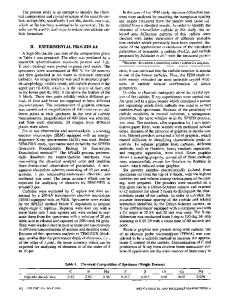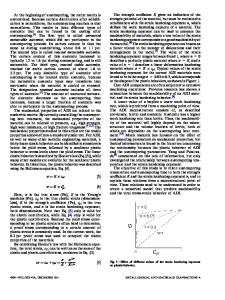A transmission electron microscope study of 1 Pct Mn ductile iron with different austempering treatments
- PDF / 2,061,981 Bytes
- 10 Pages / 612 x 792 pts (letter) Page_size
- 63 Downloads / 362 Views
I.
INTRODUCTION
AUSTEMPERED ductile iron (ADI) has received much publicity as more applications have been reported.[1,2] Austempered ductile iron offers a combination of strength and wear resistance with low cost and good toughness. Achieving optimal mechanical properties of ADI is a function of retained austenite, untransformed austenite volume, and carbide precipitation in both the ferritic and austenitic components of bainite, which in turn are controlled by alloying elements, austempering time, and temperature. In ADI, a minimal level of hardenability is required in the austempering process to prevent pearlite formation. Manganese, an inexpensive and potent hardenability promoter, may be added to iron for this purpose. However, Mn on the other hand is known to segregate in the intercellular regions and causes heterogeneous microstructure formation during austempering.[3–10] Inasmuch as Mn alters the kinetics of bainitic transformations in ductile iron, it will control carbide precipitation as well. This article is a report of an investigation of bainitic reaction in ADI containing 1 wt pct Mn and treated with conventional and successive austempering.[8,9] The successive austempering process for the first time was introduced by the author to improve mechanical properties of high Mn ADI. It was shown that application of successive austempering on 1 wt pct Mn ductile iron improves its mechanical properties much more than a conventional austempering process.[8,9] Subsequently, Bayati et al.[11] also applied this process on the same material, and their results confirmed the beneficial effect of successive austempering. To understand the effect of austempering variables on the mechanical properties of ADI, it is necessary to undertake a detailed characterization of bainitic structure of ducM. NILI AHMADABADI, Assistant Professor, is with the Faculty of Engineering, Tehran University, Tehran, Iran. Manuscript submitted February 4, 1997. METALLURGICAL AND MATERIALS TRANSACTIONS A
tile iron treated by different austempering processes. Bainitic transformation at high austempering temperature (375 7C) for short and medium austempering times was extensively discussed in previous work.[12] In this article, special attention is paid to carbide precipitation in upper bainite formed during long-time austempering, carbide precipitation in lower bainite, and the effect of successive austempering on bainitic transformation in 1 pct Mn ductile iron. II.
EXPERIMENTAL PROCEDURE
A high Mn ductile iron with the composition given in Table I was prepared. The alloy was produced by sandwich spheroidization treatment, and 1-in.-thick Y block castings were poured in green sand molds. Base irons were treated with 5.5 wt pct MgFeSi alloy for spheroidization followed by postinoculation with 75 wt pct FeSi. The wafer specimens were cut from Y blocks and austenitized for 90 minutes in an atmosphere-controlled furnace at 900 7C, austempered for various times in a salt bath at 375 7C for high austempering temperature (HAT process) or at 315
Data Loading...











